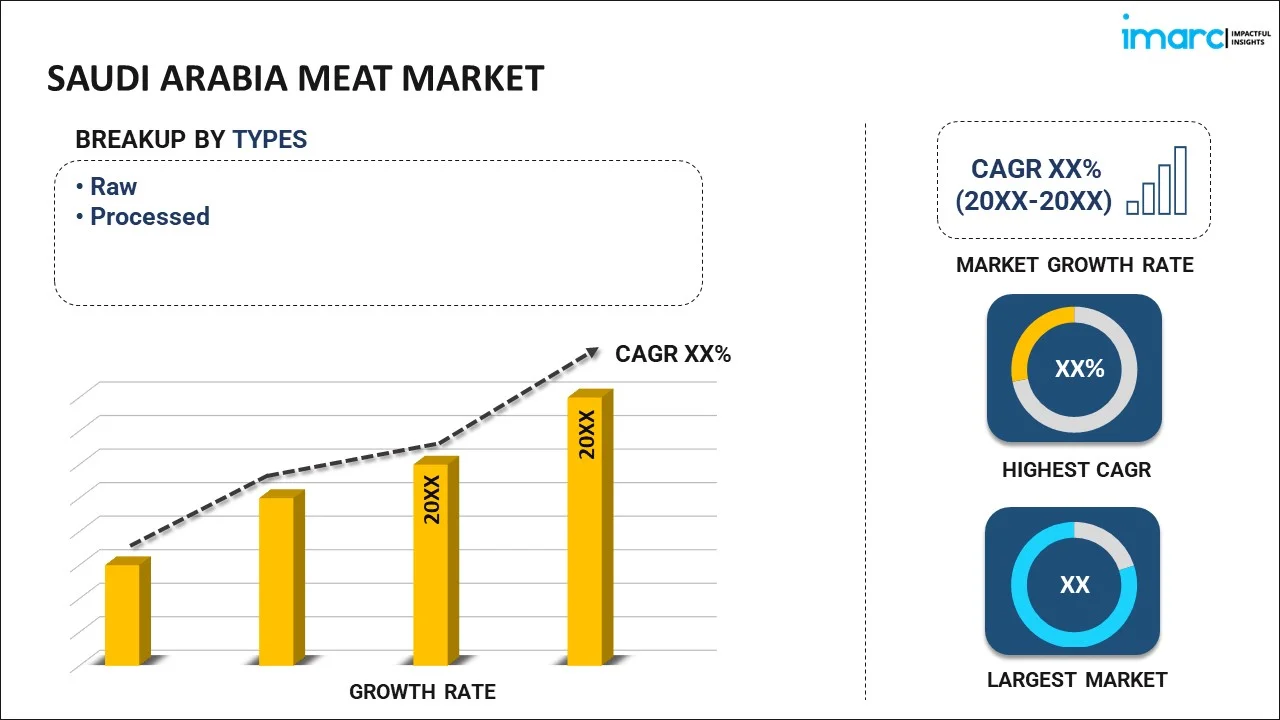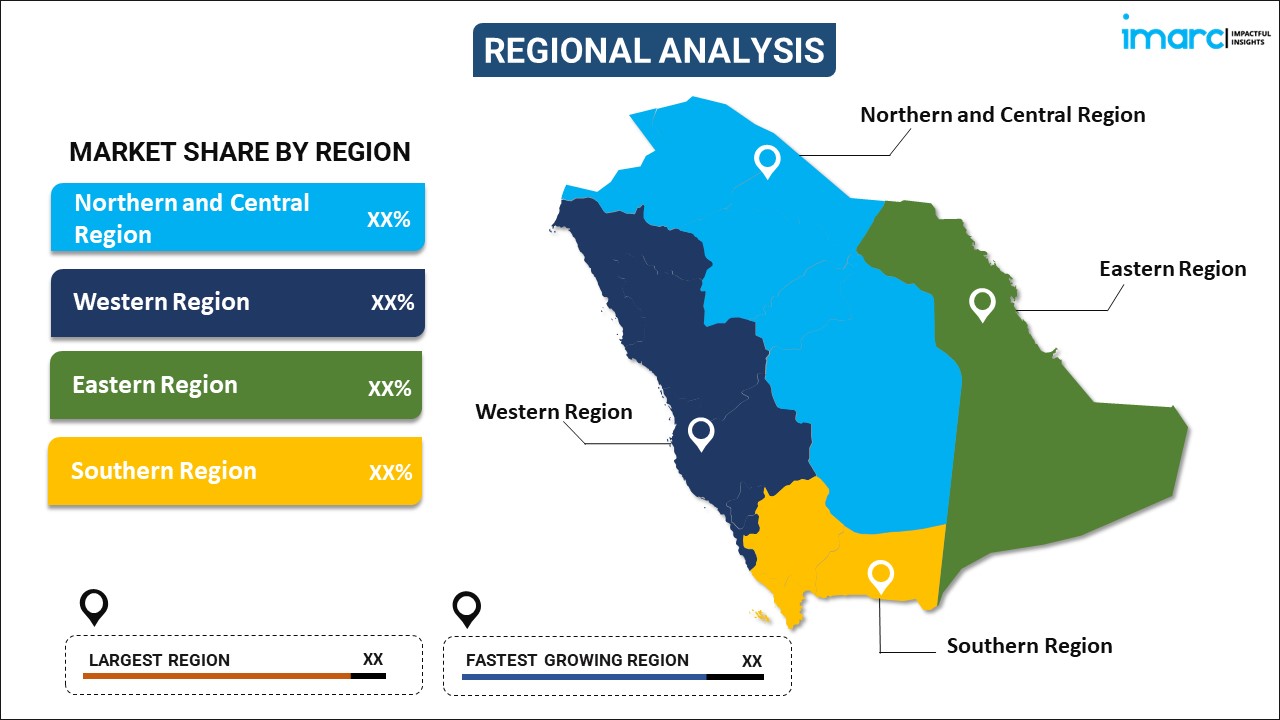
Saudi Arabia Meat Market Report by Type (Raw, Processed), Product (Chicken, Beef, Mutton, and Others), Distribution Channel (Supermarkets and Hypermarkets, Departmental Stores, Specialty Stores, Online Stores, and Others), and Region 2026-2034
Market Overview:
Saudi Arabia meat market size reached USD 14.0 Billion in 2025. Looking forward, IMARC Group expects the market to reach USD 21.5 Billion by 2034, exhibiting a growth rate (CAGR) of 4.90% during 2026-2034. The rapid population growth in Saudi Arabia, increasing disposable income in the country, widespread preference for different meat products, shifting trends toward lean meats, the booming tourism industry, and rapid expansion of retail spaces represent some of the key factors driving the market.
|
Report Attribute
|
Key Statistics
|
|---|---|
|
Base Year
|
2025
|
|
Forecast Years
|
2026-2034
|
|
Historical Years
|
2020-2025
|
|
Market Size in 2025
|
USD 14.0 Billion |
|
Market Forecast in 2034
|
USD 21.5 Billion |
| Market Growth Rate 2026-2034 | 4.90% |
Meat refers to the flesh of animals that is used as a fundamental component of many diets. It includes various types, such as beef, poultry, pork, lamb, and seafood, each characterized by distinct flavors, textures, and nutritional profiles. The processing of meat involves several stages, including slaughtering, butchering, curing, smoking, and aging. It finds extensive applications in various dishes, such as steaks, stews, grilled items, and complex recipes. Meat is known for its high protein content, essential amino acids, vitamins, and different minerals like iron and zinc. It also aids in building and repairing tissues, strengthening the immune system, supporting body function, preventing iron deficiency, reducing calorie intake, and improving overall health. Moreover, meat provides several advantages, such as vast employment opportunities, adaptability to different cuisines, and cultural preferences.
Saudi Arabia Meat Market Trends:
The rapid population growth in Saudi Arabia, which consumes meat and meat-based products, are propelling the market growth. Additionally, the increasing disposable income in the country, leading to more spending on diverse and high-quality meat products, is contributing to the market growth. Besides this, rapid urbanization, which directly correlates with greater access to and demand for varied meat products, is boosting the market growth. Furthermore, the widespread preference for different meat products, such as lamb and chicken, in Saudi cuisine is driving the market growth. In addition, the shifting trend towards lean meats like chicken and fish as healthier options is acting as another growth-inducing factor. Apart from this, the booming tourism sector, which increases the demand for meat in hotels and restaurants, is catalyzing the market growth. Moreover, the rapid expansion of retail spaces, like supermarkets and hypermarkets, making meat products more accessible to broader consumers, is supporting the market growth. Along with this, the imposition of various government policies focusing on food security, thus encouraging domestic meat production and processing, is strengthening the market growth. In line with this, recent innovations in meat processing and preservation, which enhance product quality and shelf life, are bolstering the market growth. Additionally, the escalating reliance on meat and its products among the population, owing to the limited agricultural capacity of Saudi Arabia, is fueling the market growth. Furthermore, the growing collaborations with international meat suppliers to ensure a steady supply chain are favoring the market growth. In addition to this, the ongoing shift towards protein-rich diets in Saudi Arabia, which is facilitating meat consumption, is acting as another growth-inducing factor. Besides this, the rising number of online meat shopping platforms, making it easier for consumers to access a variety of meat products, is positively impacting the market growth.
Saudi Arabia Meat Market Segmentation:
IMARC Group provides an analysis of the key trends in each segment of the market, along with forecasts at the country level for 2026-2034. Our report has categorized the market based on type, product, and distribution channel.
Type Insights:

- Raw
- Processed
The report has provided a detailed breakup and analysis of the market based on the type. This includes raw and processed.
Product Insights:
- Chicken
- Beef
- Mutton
- Others
A detailed breakup and analysis of the market based on the product have also been provided in the report. This includes chicken, beef, mutton, and others.
Distribution Channel Insights:
- Supermarkets and Hypermarkets
- Departmental Stores
- Specialty Stores
- Online Stores
- Others
The report has provided a detailed breakup and analysis of the market based on the distribution channel. This includes supermarkets and hypermarkets, departmental stores, specialty stores, online stores, and others.
Regional Insights:

- Northern and Central Region
- Western Region
- Eastern Region
- Southern Region
The report has also provided a comprehensive analysis of all the major regional markets, which include Northern and Central Region, Western Region, Eastern Region, and Southern Region.
Competitive Landscape:
The market research report has also provided a comprehensive analysis of the competitive landscape in the market. Competitive analysis such as market structure, key player positioning, top winning strategies, competitive dashboard, and company evaluation quadrant has been covered in the report. Also, detailed profiles of all major companies have been provided. Some of the key players include:
- Al-Watania Poultry
- Almarai Food Company
- Halwani Bros Company
- Sunbulah Group
- Tanmiah Food Company
(Please note that this is only a partial list of the key players, and the complete list is provided in the report.)
Saudi Arabia Meat Market Report Coverage:
| Report Features | Details |
|---|---|
| Base Year of the Analysis | 2025 |
| Historical Period | 2020-2025 |
| Forecast Period | 2026-2034 |
| Units | Billion USD |
| Scope of the Report | Exploration of Historical Trends and Market Outlook, Industry Catalysts and Challenges, Segment-Wise Historical and Future Market Assessment:
|
| Types Covered | Raw, Processed |
| Products Covered | Chicken, Beef, Mutton, Others |
| Distribution Channels Covered | Supermarkets and Hypermarkets, Departmental Stores, Specialty Stores, Online Stores, Others |
| Regions Covered | Northern and Central Region, Western Region, Eastern Region, Southern Region |
| Companies Covered | Al-Watania Poultry, Almarai Food Company, Halwani Bros Company, Sunbulah Group, Tanmiah Food Company, etc. |
| Customization Scope | 10% Free Customization |
| Post-Sale Analyst Support | 10-12 Weeks |
| Delivery Format | PDF and Excel through Email (We can also provide the editable version of the report in PPT/Word format on special request) |
Key Questions Answered in This Report:
- How has the Saudi Arabia meat market performed so far and how will it perform in the coming years?
- What has been the impact of COVID-19 on the Saudi Arabia meat market?
- What is the breakup of the Saudi Arabia meat market on the basis of type?
- What is the breakup of the Saudi Arabia meat market on the basis of product?
- What is the breakup of the Saudi Arabia meat market on the basis of distribution channel?
- What are the various stages in the value chain of the Saudi Arabia meat market?
- What are the key driving factors and challenges in the Saudi Arabia meat?
- What is the structure of the Saudi Arabia meat market and who are the key players?
- What is the degree of competition in the Saudi Arabia meat market?
Key Benefits for Stakeholders:
- IMARC’s industry report offers a comprehensive quantitative analysis of various market segments, historical and current market trends, market forecasts, and dynamics of the Saudi Arabia meat market from 2020-2034.
- The research report provides the latest information on the market drivers, challenges, and opportunities in the Saudi Arabia meat market.
- Porter's five forces analysis assist stakeholders in assessing the impact of new entrants, competitive rivalry, supplier power, buyer power, and the threat of substitution. It helps stakeholders to analyze the level of competition within the Saudi Arabia meat industry and its attractiveness.
- Competitive landscape allows stakeholders to understand their competitive environment and provides an insight into the current positions of key players in the market.
Need more help?
- Speak to our experienced analysts for insights on the current market scenarios.
- Include additional segments and countries to customize the report as per your requirement.
- Gain an unparalleled competitive advantage in your domain by understanding how to utilize the report and positively impacting your operations and revenue.
- For further assistance, please connect with our analysts.
 Request Customization
Request Customization
 Speak to an Analyst
Speak to an Analyst
 Request Brochure
Request Brochure
 Inquire Before Buying
Inquire Before Buying




.webp)




.webp)












